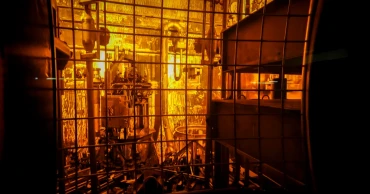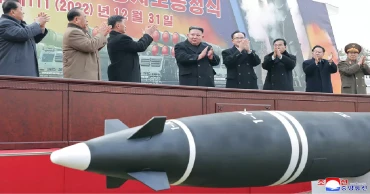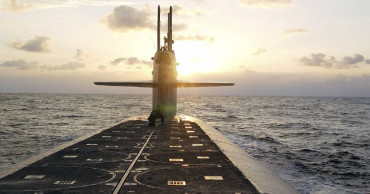nuclear arsenal
US nuclear agency falls short on scheduling, cost estimates
The U.S. agency in charge of jumpstarting the production of key components for the nation’s nuclear arsenal is falling short when it comes to having a comprehensive schedule for the multibillion-dollar project.
The Government Accountability Office said in a report released Thursday that plans by the National Nuclear Security Administration for reestablishing plutonium pit production do not follow best practices and run the risk of delays and cost overruns.
The federal government has not manufactured plutonium cores regularly in more than 30 years and faces a congressionally mandated deadline of turning out at least 80 per year by 2030.
The GAO describes the modernization effort as the agency’s largest investment in weapons production infrastructure to date, noting that plutonium is a dangerous material and making the weapon cores is difficult and time consuming.
“NNSA lacks both a comprehensive cost estimate and a schedule outlining all activities it needs to achieve this capability,” the reports states.
Read more: Japan reverts to max nuclear power to tackle energy, climate
Nuclear watchdog groups have been voicing similar concerns since the federal government first announced plans in 2018 to restart production by splitting the work between Los Alamos National Laboratory in northern New Mexico and the Savannah River Site in South Carolina.
At stake are billions of dollars in funding for improving infrastructure at the two locations and thousands of jobs.
Democratic members of New Mexico's congressional delegation have fought to ensure Los Alamos — a once secret city that helped develop the atomic bomb as part of the Manhattan Project — would be among the benefactors of the lucrative mission.
Using documents prepared by the nuclear agency for justifying its fiscal year 2023 budget, the GAO identified at least $18 billion to $24 billion in potential costs to build up production capacity.
However, the GAO, other independent analysts and officials in the U.S. Defense Department all have testified in recent years that NNSA would miss the 2030 deadline, no matter how much funding was funneled toward the project.
The NNSA said in a statement Thursday that it agreed with the GAO's recommendations and that some of the work to implement best practices was underway.
“Both the lifecycle cost estimate data and (integrated master schedule) will be updated as needed to reflect the most up-to-date information as the projects and program work progress,” the agency said.
More specifically, the agency said in a letter to the GAO that it planned to complete the cost estimate for the overall project by September 2025 and that the schedule would “continue to mature over time.”
Greg Mello, director of the watchdog Los Alamos Study Group, said Thursday that not having a comprehensive schedule or cost estimate means NNSA does not know what it's doing and has little likelihood of success.
“How can NNSA produce the required number of pits on schedule or on budget, when NNSA has no schedule or budget?” he asked. “These are elementary, normal components in any program or project. After more than two decades of preparation, NNSA doesn’t have them.”
Read more: UN nuclear agency to probe Russia claim of `dirty bombs'
Jay Coghlan, executive director of Nuclear Watch New Mexico, pointed to some of the price tags associated with the project having doubled over the last four years. He said production overall at the two sites could cost at least $60 billion over 30 years with radioactive waste disposal and other environmental and public health concerns adding to the bill.
Until Congress and the New Mexican delegation demand credible cost estimates and schedules, Coghlan said lawmakers “should stop rewarding the guilty with yet more money.”
"That is simple good governance that could help slow our sleepwalk into the new and unpredictable nuclear arms race,” he said.
Mello agreed, saying the mission needs to be widely debated in Congress, not just discussed behind closed doors or by those lawmakers who sit on defense committees.
In its report, the GAO outlined the process for making plutonium pits along with a history of how and where the work was done during the Cold War. The long-shuttered Rocky Flats Plant outside Denver was capable of producing more than 1,000 war reserve pits annually before work stopped in 1989 due to environmental and regulatory concerns.
With a long history of leaks, fires and other violations, Rocky Flats underwent a $7 billion cleanup that was finished in 2005.
During the Obama administration, a council made up of defense and energy officials told Congress the nation needed to produce between 50 and 80 pits per year. Congress included a legal mandate for production in a 2015 defense measure that was subsequently approved and signed by the president.
That mandate was later amended to call for the 80 pits in 2030. According to the GAO, some of the construction projects and upgrades needed for the work at Los Alamos won't be finished for several years.
2 years ago
NKorea's Kim orders 'exponential' expansion of nuke arsenal
North Korean leader Kim Jong Un ordered the “exponential” expansion of his country's nuclear arsenal and the development of a new, more powerful intercontinental ballistic missile, state media reported Sunday, after he entered 2023 with another weapons test following a record number of missile firings last year.
Kim’s moves are in line with the broad direction of his nuclear weapons development program as he has repeatedly vowed to boost both the quality and quantity of his arsenal. Some experts said Kim will likely continue a provocative run of weapons tests this year before he would ultimately try to use his enlarged arsenal to wrest concessions like sanctions relief in future dealings with his rivals.
“They are now keen on isolating and stifling (North Korea), unprecedented in human history,” Kim said at a recently ended ruling party meeting, according to the official Korean Central News Agency. “The prevailing situation calls for making redoubled efforts to overwhelmingly beef up the military muscle to thoroughly guarantee the sovereignty, security and fundamental interests of (the country).”
Kim accused South Korea of being “hell-bent on imprudent and dangerous arms build-up” and openly trumpeting its preparations for war with North Korea. That, Kim said, highlights the need to mass-produce battlefield tactical nuclear weapons and calls for “an exponential increase of the country’s nuclear arsenal,” KCNA said.
Kim also set forth a task to develop another ICBM system “whose main mission is quick nuclear counterstrike," KCNA said, without elaborating.
Read more: North Korea's Kim lays out key goals to boost military power
Kim accused the United States of frequently deploying nuclear strike means in South Korea, boosting trilateral military cooperation with South Korea and Japan and pushing to establish a NATO-like regional military bloc.
Tactical nuclear weapons and a military reconnaissance satellite are among an array of weapons systems that Kim has vowed to introduce in recent years. Other weapons he wants include a multi-warhead missile, a more agile solid-fueled ICBM, an underwater-launched nuclear missile and a hypersonic weapon.
Outside worries about North Korea’s nuclear program have grown since the North last year approved a new law that authorized the preemptive use of nuclear weapons in a broad range of situations and openly threatened to use its nuclear weapons first.
During his speech at the party meeting, Kim reiterated that threat.
“(Kim's report) made clear that our nuclear force considers it as the first mission to deter war and safeguard peace and stability. However, if it fails to deter, it will carry out the second mission, which will not be for defense,” KCNA said.
The North’s increasing nuclear threats have prompted the United States and South Korea to expand their regular exercises and strengthen a trilateral security cooperation involving Japan. The U.S. military has warned any nuclear attack by North Korea against the United States or its allies and partners “will result in the end of that regime.
“It was during his 2018 New Year’s speech that (Kim) first ordered the mass production of warheads and ballistic missiles, and he’s doubling down on that quantitative expansion goal in the coming year,” said Ankit Panda, an expert with the Carnegie Endowment for International Peace.
Panda said the reference to a new ICBM appears to concern a solid-propellant system. “We should expect to see larger, solid propellant missiles tested soon,” he said.
Last month, North Korea said Kim supervised the test of a “high-thrust solid-fuel motor” for a new strategic weapon. Experts say the weapon refers to a solid-fueled ICBM, which can be launched more quickly than a liquid-fueled ICBM because the fuel in solid-propellant rockets is already loaded inside. All of North Korea's previously tested ICBMs use liquid propellants.
Read more: Kim claims N. Korean successes, wants to overcome challenges
Earlier Sunday, South Korea’s military detected the missile launch from the North’s capital region. The Joint Chiefs of Staff said in a statement the missile traveled about 400 kilometers (250 miles) before falling into the water between the Korean Peninsula and Japan.
The Joint Chiefs of Staff called the launch “a grave provocation” that hurts peace and security on the Korean Peninsula and around the world. It said South Korea closely monitors North Korean moves in coordination with the United States and maintains a readiness to overwhelmingly deal with any provocations.
The U.S. Indo-Pacific Command said in a statement that the launch highlights “the destabilizing impact” of North Korea’s unlawful weapons programs. It said U.S. commitments to defend South Korea and Japan “remain ironclad.”
North Korea test-fired more than 70 missiles last year. The North’s testing spree indicated the country is likely emboldened by its advancing nuclear program, though whether the country has functioning nuclear missiles remains a source of outside debate.
On Saturday, North Korea fired three short-range ballistic missiles toward its eastern waters.
North Korea’s state media confirmed Sunday that the country conducted the test-firings of its super-large multiple rocket launcher to test the weapon’s capability. KCNA said three shells fired from the launcher on Saturday accurately hit an island target off the country's eastern coast. It said North Korea fired another shell from the launcher toward its eastern waters Sunday.
Kim Jong Un said the rocket launcher put all of South Korea within striking distance and is capable of carrying a tactical nuclear warhead, according to KCNA.
Outside experts categorize weapons fired from the launcher as ballistic missiles because of their trajectories, ranges and other characteristics.
The North’s missile launch for a second straight day came after South Korea on Friday conducted a rocket test related to its plan to establish space-based surveillance to better monitor North Korea. On Friday, South Korea’s military said it test-launched a solid-fueled rocket, a type of a space launch vehicle that it plans to use to put its first spy satellite into orbit in coming years.
Animosities between the rival Koreas have deepened since early last week, when South Korea accused North Korea of flying drones across the countries’ heavily fortified border for the first time in five years and sent its own drones toward the North.
South Korea acknowledged it failed to shoot down any of the five North Korean drones it said were found south of the border. But South Korea has vowed to bolster its air defense network and get tough on future provocations by North Korea.
2 years ago
US adds 'low yield' nuclear weapon to its submarine arsenal
The U.S. military has deployed a new addition to its nuclear arsenal — a long-range missile armed with a nuclear warhead of reduced destructive power. The so-called low-yield missile joins other, more powerful weapons aboard stealthy submarines prowling the oceans.
5 years ago





